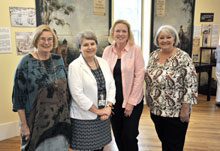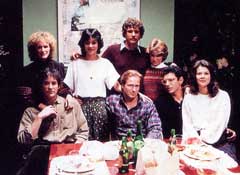Mark Shaffer chats with Sandlapper Magazine’s Editor Aida Rogers about the new book based on the publication’s legendary food column. Prologue:  I have a confession to make. I used to envy my old friend and occasional editor, Aida Rogers. She had what pretty much seemed like a dream job to me. She wrote for Sandlapper Magazine, got to travel all over the state, meet interesting people, chronicle the colorful local culture and generally do cool stuff while I mostly rode a desk ( or so it seemed). But what I envied most of all was that Aida got paid to eat and write about it. Her column, Stop Where the Parking Lot’s Full, was the reason an awful lot of people have subscribed to Sandlapper over the years. She always managed to make me want to hop in the car and burn rubber to some hole-in-the-wall barbecue joint at a crossroads community uncharted by Rand McNally that might as well be WhatTheHell, South Carolina. I’ve had the privilege to participate in a few of these food safaris over the years and always managed to take away something new with each outing – and I don’t mean doggie bags or pilfered silver.
I have a confession to make. I used to envy my old friend and occasional editor, Aida Rogers. She had what pretty much seemed like a dream job to me. She wrote for Sandlapper Magazine, got to travel all over the state, meet interesting people, chronicle the colorful local culture and generally do cool stuff while I mostly rode a desk ( or so it seemed). But what I envied most of all was that Aida got paid to eat and write about it. Her column, Stop Where the Parking Lot’s Full, was the reason an awful lot of people have subscribed to Sandlapper over the years. She always managed to make me want to hop in the car and burn rubber to some hole-in-the-wall barbecue joint at a crossroads community uncharted by Rand McNally that might as well be WhatTheHell, South Carolina. I’ve had the privilege to participate in a few of these food safaris over the years and always managed to take away something new with each outing – and I don’t mean doggie bags or pilfered silver.
I ceased to envy Aida about the time I came up with The Moveable Feast for The Lowcountry (then Lowcountry Weekly) and realized just how much work a food column is, much less a full-blown feature with a table full of “feasters” to keep track of along with a phalanx of chefs, servers and management breathing down your neck. It’s a little like herding cats, but you won’t find me complaining. I still consider TMF a minor miracle.
Meanwhile, in celebration of Sandlapper’s 40th anniversary, the source of my inspiration has been given the ultimate honor for a column: the book treatment. A few years ago Aida moved behind the Editor’s desk and longtime contributor (and Lexington attorney) Tim Driggers inherited the column. He’s done it proud. The book version of Stop Where The Parking Lot’s Full is an updated guide to the best chow, high end, low end and everything end in-between that the Palmetto State has to offer – all organized by region. Beaufort favorites Emily’s Restaurant and Tapas Bar, Saltus River Grill and Steamer Oyster & Steakhouse all made the cut as did the Squat ‘n’ Gobble in Bluffton, Gullah Grub on St. Helena Island, and Marshside Mama’s on Daufuskie Island. Hilton Head is represented by Charley’s Crab, Charlie’s L’Etoile Vert, Old Fort Pub, and Truffles Market and Café. 
The authors will be in Beaufort to sign (and hopefully sell) copies of the book at two events. While Esquire Driggers’ schedule didn’t allow us to connect prior to deadline, I did catch up with his co-author and editor by phone at the magazine’s midlands office.
MS: We met back in ’88?
AR: I think we met when we went from Florence on the train to Kingstree to eat at The Station House. I think you interviewed [Sandlapper Publisher] Bob Wilkins for Sumter ETV when Sandlapper came back, ‘cause he knew about you and he told me that you and I needed to work on some stories together. And then you and I had eaten at The Grotto [in Florence]. We have a history of eating.
MS: We do have a history of eating and if there’s a history to have, that’s the history to have.
AR: (laughing) That is the history to have.
MS: So, we have this history, but you’ve documented it a bit better than I have. When did you start “Stop Where the Parking Lot’s Full” and how long did you do it?
AR: Sandlapper came back into publication in December of 1989, so I would have been writing those first restaurant reports in the autumn of 1989.
MS: Can you remember what the first one was?
AR: It was Miller’s Bread Basket which is in Blackville – the Mennonite place – and also Cromer’s Cafeteria in Kershaw. Both were home style “meat & three-ish” small town places. Even though we’ve done a lot of city restaurants – Charleston and Columbia, Greenville – I think we’re kind of known for those small town only-cafe-in-town sort of places.
MS: Well, first of all you have to have a parking lot and then it has to be full and then you have to be able to see it and stop there, knowing that people actually drive to this destination and choose it.
AR: Regularly.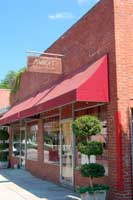
MS: Regularly.
MS: So you started it back in ’89 and you did it through when?
AR: Fifteen years. My last one was winter [edition] 2004-2005.
MS: And then you were unceremoniously dumped by yourself (Aida moved to the Editor’s desk in 2005).
AR: Ha! You know, I got really tired of it. There’s so much travel involved and – believe it or not – you do get tired of eating. And it’s work. I think people at first blush think ‘Oh what fun!’ and it is fun, but you’re taking notes the whole time. You’re listening to people and you’re trying to be very careful about what you observe and what they’re saying – and it’s important to them. They want to tell you, but it’s really a lot of information to cull down for such a long period of time.
MS: Yeah.
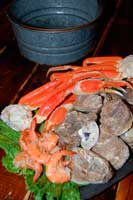 AR: Personally I’m a generalist. I don’t like to be so specific all the time about the subjects that I write, and I was done with food. I think you and I are different that way ‘cause you’re a real foodie, Mark, aren’t you?
AR: Personally I’m a generalist. I don’t like to be so specific all the time about the subjects that I write, and I was done with food. I think you and I are different that way ‘cause you’re a real foodie, Mark, aren’t you?
MS: (much hemming and hawing) I don’t know if I’m a purist in that sense of the word, but I certainly have taken the direct inspiration for the piece that we do on a regular basis – The Moveable Feast – from Stop Where the Parking Lot’s Full.
AR: The Moveable Feast, what a great name. Of course, I know where it comes from but great idea and concept.
MS: We apologize to Ernie [Hemingway] in each issue.
AR: (laughs) He’d be thrilled.
MS: I’m sure he’d prefer a little more bar time than we spend.
AR: (laughs)
MS: So in your fifteen years what are some of the standouts? Are there still experiences you look back on and go ‘I’ll never forget that.’
AR: Oh yeah. Yeah. And the places that stand out to me are the ones that are eclectic and funky and run by people who really know what they’re doing – and they tend to be in the unexpected, hidden away places. Now Aiken isn’t hidden away but there’s a restaurant there called Riley’s Whitby Bull. It’s run by a couple, both Culinary Institute of America graduates, they’re off the main drag. They bought this Queen Anne house and named it after this book set in England. Anyway, they have really great food. They’re like old hippies – they call themselves that – and she greets you at the door with a magic wand and sometimes a jester’s hat, and when you enter her home you are coming into her world and you’re supposed to leave your troubles outside.
And there’s another one one in the Old Ninety-six District, La Cantina – in Clark’s Hill (page 90) And that’s another couple – I guess you’d call them old hippies, too. She’s a great niece of “Pitchfork” Ben Tillman and a potter and horticulturalist, he’s a classical guitarist and a ventriloquist and a carver…
And then there’s the Old House Smoke House near Ridgeland (page 285). That’s a very unusual place and that gentleman came from New Orleans and he is the one, he says, who brought the “crispy flounder dish” to South Carolina. It’s a Thai thing. Name’s Frank Crutchfield.
AR: I was thinking that as cities and towns spread into each other and everything becomes homogenized and “O’Charley-fied” this is proof that not all of South Carolina is like this. These are all one-of-a-kind places and a lot of them are – what is the right word? 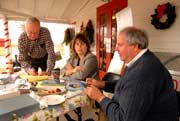
MS: Unique?
AR: Yeah! And they reflect their communities. So, if you’re going to go to Big Fish in Litchfield, you know you’re in Litchfield. And at The Cyclone where you get this really great baked potato in Chester, you’re in Chester. I think a Cyclone actually came through the town, maybe the high school mascot’s a cyclone.
MS: It’s a slice of that community.
AR: Right. It’s flavor in more ways than one.
MS: And that’s what good food writing’s about.
MS: I know that I don’t want to read about texture, flavor – dribbles of oregano – I’m personally not interested in that. I’m more interested in what’s all around the food.
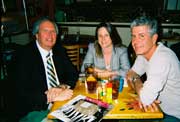 MS: When you decided that you’d had enough, that you’re going to be The Editor and hand out the assignments, how did you decide on Tim?
MS: When you decided that you’d had enough, that you’re going to be The Editor and hand out the assignments, how did you decide on Tim?
AR: Tim has done freelance work for us forever, even the old Sandlapper when it started in 1968 he had done some writing, and he’s right here in Lexington. He had gone with me a couple of times to do some of these restaurant reports and I watched him. Part of what I do is talk to the regular customers, and he just got up and started doing that. He really enjoyed it and he’s good with people. You’ve got to have that curiosity, that quality that lets people open up to you. So I offered it to him.
MS: Plus his background is the law, he’s a lawyer.
AR: But he’s written forever. He’s written humor columns, he’s really knowledgeable about music and has reviewed music for years, and he’s a very entertaining personality, kind of a natural for writing a column. He’s got a little comedian in him. And through his political work he’s met a lot of people all over the state and he’s got a good sense of South Carolina. As a lawyer he would have gone to law school with a lot of people from around the state. So, he’s got that sense of South Carolina that a lot of new people – no matter how curious they are, no matter how well-researched they are – you just don’t have that unless you’re from here. {mosimage}
And he knows food. Now, he’ll tell you that all he eats are beanie weenies, but he is a big New York City person, he’s been there many, many times and he eats well when he goes there and tries different kinds of food. He’s not as “country bumpkin” as he would let you believe.
MS: This is the first book signing in the Lowcountry?
AR: It is. We’ve been to Aiken and Edgefield, we’ve been to Greenville, Anderson and Clemson and several in Columbia…
MS: What sort of reaction are you getting? Are folks coming in and saying “I remember this place. I went here because I read the [piece] in the magazine”?
AR: Some people are. Some have said “we saved the magazine because we wanted to go visit this place and now here we have it in the book.” And that was the point all along behind the book, to just collect all of this information so people could have it in one spot. Of course, what’s disappointing is that so many of these places have closed. I think all together we’ve covered maybe 300 restaurants and I think we’ve got 159 left of the ones we’ve written about. People died or closed, there were fires.
MS: A lot of landmarks fall by the wayside over time. In all the years of doing the column, what was the standout meal – the one thing? Can you conjure one?
AR: Yeah, yeah I can. I’d have to say it was La Cantina. That place was just so unexpected and eclectic. (consults the book) Here we go. (reading) Tonight’s special: I got the cornish game hen stuffed with Grand Marnier mango chutney. I love mango.
A part of all [the experience] is that this place is so hard to find, you can get lost finding it, then you find it and there [the owner] is playing that Spanish guitar and (sighs) you’re in South Carolina. Who’d have thunk? And really part of this book proves – as does Sandlapper, I hope – that there are educated, well-informed, unexpected people here doing good things, doing good food and they’re selling it for a lot cheaper than you would get it somewhere else.
Aida Rogers and Tim Driggers will visit Beaufort Saturday, March 21 to sign copies of their book Stop Where the Parking Lot’s Full during two sessions: 1 – 4 p.m. at Bay Street Trading Company, 808 Bay St., and 5 – 7 p.m. at Emily’s Restaurant & Tapas Bar (featured in the book), 906 Port Republic St.
All proceeds from the sale of Stop Where the Parking Lot’s Full help fund the continued publication of the non-profit Sandlapper Magazine. I highly recommend you stop by and pick one up. Mine’s going straight in the glove compartment for the next time I’m hungry and find myself in WhereTheHellAmI, South Carolina.



